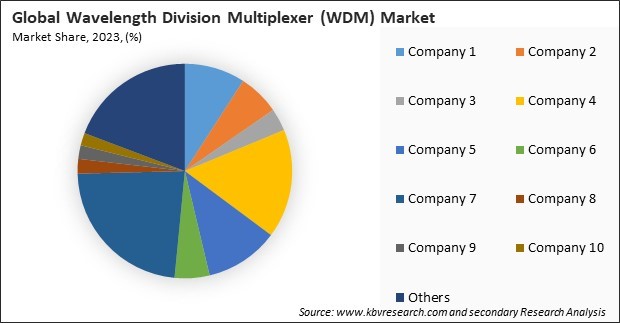“Global Wavelength Division Multiplexer (WDM) Market to reach a market value of USD 7.40 Billion by 2031 growing at a CAGR of 6.1%”
The Global Wavelength Division Multiplexer (WDM) Market size is expected to reach $7.40 billion by 2031, rising at a market growth of 6.1% CAGR during the forecast period.
The Asia Pacific segment recorded 38% revenue share in the market in 2023. The rapid expansion of telecommunications infrastructure, increasing internet penetration, and the widespread deployment of 5G networks have significantly driven the demand for WDM technology in the region. Countries like China, India, Japan, and South Korea invest heavily in fiber-optic networks to support high-speed data transmission and digital transformation initiatives.

The increasing reliance on high-speed internet for personal and professional applications is a significant driver for the market. The growing demand for video streaming, online gaming, remote work, and cloud-based applications requires a robust network infrastructure supporting high data transmission rates. With internet traffic growing exponentially, service providers are upgrading their optical networks to ensure seamless connectivity and avoid bandwidth congestion. Thus, rising demand for high-speed internet and expanding network infrastructure drives the market's growth.
Additionally, The rise of smart manufacturing and industrial IoT (IIoT) is revolutionizing the automotive, aerospace, healthcare, and logistics industries by integrating automation, robotics, and real-time data analytics. Smart factories rely on interconnected devices and sensors that continuously generate vast amounts of data, which must be transmitted securely and with minimal latency. Therefore, expanding smart manufacturing and industrial IoT (IIoT) applications is driving the market's growth.
However, One of the primary barriers to WDM adoption is the high initial investment required for deployment. The technology involves costly optical components such as multiplexers, demultiplexers, transceivers, and optical amplifiers, which can significantly increase network operators' capital expenditures. Smaller enterprises and regional service providers may struggle to afford these advanced networking solutions, limiting their ability to compete with larger market players. In conclusion, WDM technology's high initial investment and deployment costs hamper the market's growth.

The leading players in the market are competing with diverse innovative offerings to remain competitive in the market. The above illustration shows the percentage of revenue shared by some of the leading companies in the market. The leading players of the market are adopting various strategies in order to cater demand coming from the different industries. The key developmental strategies in the market are Acquisitions, and Partnerships & Collaborations.
On the basis of industry vertical, the market is classified into telecom operators, data centers, government and defense, healthcare, and others. The data centers segment recorded 22% revenue share in the market in 2023. With the exponential growth of cloud computing, artificial intelligence, and big data analytics, data centers require high-bandwidth and low-latency optical networks for efficient data transmission. WDM technology is crucial in interconnecting data centers and managing large data traffic volumes.

Based on type, the market is characterized into CWDM and DWDM. The CWDM segment procured 36% revenue share in the market in 2023. CWDM technology uses wider spacing between wavelengths, making it a cost-effective alternative to DWDM for short- and medium-distance applications. It is commonly used in metro and access networks and enterprise and cable television (CATV) applications.
Free Valuable Insights: Global Wavelength Division Multiplexer (WDM) Market size to reach USD 7.40 Billion by 2031
Region-wise, the market is analyzed across North America, Europe, Asia Pacific, and LAMEA. The North America segment witnessed 30% revenue share in the market in 2023. The region’s early adoption of advanced networking technologies and continuous investments in fiber-optic infrastructure and 5G deployment have fuelled the demand for WDM solutions. The increasing need for high-bandwidth applications such as artificial intelligence, IoT, and high-frequency trading has further contributed to market growth.
| Report Attribute | Details |
|---|---|
| Market size value in 2023 | USD 4.70 Billion |
| Market size forecast in 2031 | USD 7.40 Billion |
| Base Year | 2023 |
| Historical Period | 2020 to 2022 |
| Forecast Period | 2024 to 2031 |
| Revenue Growth Rate | CAGR of 6.1% from 2024 to 2031 |
| Number of Pages | 215 |
| Number of Tables | 270 |
| Report coverage | Market Trends, Revenue Estimation and Forecast, Segmentation Analysis, Regional and Country Breakdown, Market Share Analysis, Porter’s 5 Forces Analysis, Company Profiling, Companies Strategic Developments, SWOT Analysis, Winning Imperatives |
| Segments covered | Type, Industry Vertical, Region |
| Country scope |
|
| Companies Included | Cisco Systems, Inc., ZTE Corporation, Adtran, Inc., Nokia Corporation, Ciena Corporation, Fujitsu Limited (Fujitsu Optical Components Limited), Huawei Technologies Co., Ltd. (Huawei Investment & Holding Co., Ltd.), Corning Incorporated, Ericsson AB, and CommScope Holding Company, Inc. |
By Type
By Industry Vertical
By Geography
This Market size is expected to reach $7.40 billion by 2031.
Rising Demand for High-Speed Internet and Expanding Network Infrastructure are driving the Market in coming years, however, High Initial Investment and Deployment Costs for WDM Technology restraints the growth of the Market.
Cisco Systems, Inc., ZTE Corporation, Adtran, Inc., Nokia Corporation, Ciena Corporation, Fujitsu Limited (Fujitsu Optical Components Limited), Huawei Technologies Co., Ltd. (Huawei Investment & Holding Co., Ltd.), Corning Incorporated, Ericsson AB, and CommScope Holding Company, Inc.
The expected CAGR of this Market is 6.1% from 2023 to 2031.
The DWDM segment led the maximum revenue in the Market by Type in 2023, thereby, achieving a market value of $4.70 Billion by 2031.
The Asia Pacific region dominated the Market by Region in 2023, thereby, achieving a market value of $2.90 Billion by 2031.
Our team of dedicated experts can provide you with attractive expansion opportunities for your business.

 Drivers
Drivers
 Restraints
Restraints
 Opportunities
Opportunities
 Challenges
Challenges
